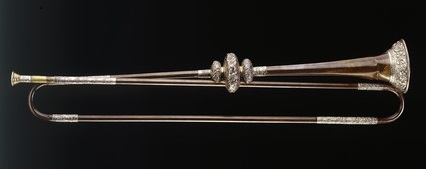My flatt trumpets derive from the late Frank Tomes’ solution to the problem presented by Talbot’s manuscript. The bell is based on a natural trumpet by Bull, ca. 1700. A bent leadpipe is included, as is a ring, adjustable by a thumbscrew, which serves as the slide grip. Pitch in C at A=466hz (Eb at A=392), with crooks for lower pitches. A straight leadpipe bit can be used to permit use as a natural trumpet in addition. Bells in 0.3mm (my preference) or 0.4mm brass.
I offer two models: the standard model, with essentially the proportions of an eighteenth-century English natural trumpet, with 4 slide positions, suited to the upper 3 voices of Purcell’s Funeral Music for Queen Mary, and the bass variant with 6 slide positions, specially developed by Tomes for bass parts in the flatt trumpet ensemble.
 These instruments have seen use recently in productions including:
These instruments have seen use recently in productions including:
ARS MORIENDI: A 2010-2012 coproduction of the Schola Cantorum Basiliensis and the Basel theater ensemble CapriConnection
The spring 2012 Schola Cantorum Basiliensis / Barockorchester La Cetra / Theater Basel coproduction of Purcell’s Fairy Queen,
Johanneskantorei Tübingen: Funeral Music for Queen Mary. November 2012
"Jubilate" Biel/Bienne, Switzerland: Funeral Music for Queen Mary. Sep. 2016
Specifications: bore: 11mm, bell 108mm.
 Sadly, few seventeenth-century English brass instruments survive: two natural trumpets and a small horn by William Bull, and a few others. None of these instruments provides much help in reconstructing the specifics of the sort of slide trumpet which is called for by Purcell in his Funeral Music for Queen Mary. The only meaningful source on the subject is a rather obtuse manuscript by the contemporary polymath James Talbot, which gives a description and a few measurements. Based on this, and using a bell after Bull (depicted), the late Frank Tomes developed a reconstruction of how the flatt trumpet may have been constructed.
Sadly, few seventeenth-century English brass instruments survive: two natural trumpets and a small horn by William Bull, and a few others. None of these instruments provides much help in reconstructing the specifics of the sort of slide trumpet which is called for by Purcell in his Funeral Music for Queen Mary. The only meaningful source on the subject is a rather obtuse manuscript by the contemporary polymath James Talbot, which gives a description and a few measurements. Based on this, and using a bell after Bull (depicted), the late Frank Tomes developed a reconstruction of how the flatt trumpet may have been constructed.
I am convinced by his solution, and with a few alterations derive my own flatt trumpet models from his.
Image: Bronze and silver trumpet, 17th century. William Bull. © Museum of London
 Flatt trumpet in C at A=466hz after Talbot / Bull / Tomes.
Flatt trumpet in C at A=466hz after Talbot / Bull / Tomes.
In the interest of encouraging performers to make more use of flatt trumpets (which appear too rarely in concert!), I exceptionally offer a version using seamless, 0.5mm wall industrially-fabricated tubing at a reduced price. Nevertheless, I strongly recommend the fully handmade model.
Please contact me directly for purchase and pricing information.